 W
WThe azure damselfly is a species of damselfly found in most of Europe. It is notable for its distinctive black and blue colouring. They are commonly found around ponds and lakesides during the summer.
 W
WThe banded demoiselle is a species of damselfly belonging to the family Calopterygidae. It is often found along slow-flowing streams and rivers. It is a Eurasian species occurring from the Atlantic coast eastwards to Lake Baikal and northwestern China.
 W
WThe beautiful demoiselle is a European damselfly belonging to the family Calopterygidae. It is often found along fast-flowing waters where it is most at home.
 W
WThe blue-tailed damselfly or common bluetail is a damselfly, belonging to the family Coenagrionidae.
 W
WCalopteryx haemorrhoidalis is a species of damselfly in the family Calopterygidae known by the common names copper demoiselle and Mediterranean demoiselle.
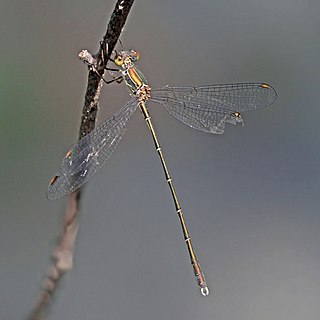 W
WChalcolestes parvidens, formerly Lestes parvidens, is a damselfly of the family Lestidae. It has a metallic green body and at rest it holds its wings away from its body. Its common name in English is the eastern willow spreadwing.
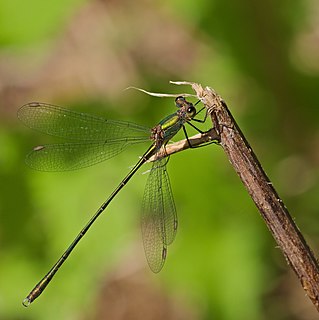 W
WChalcolestes viridis, formerly Lestes viridis, is a damselfly of the family Lestidae. It has a metallic green body and at rest it holds its wings away from its body. Its common name is the willow emerald damselfly or the western willow spreadwing.
 W
WCoenagrion hastulatum, the northern damselfly or spearhead bluet, is a damselfly in the family Coenagrionidae.
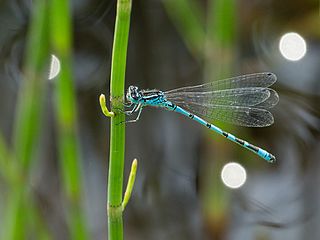 W
WCoenagrion ornatum, or, the ornate bluet, is a species of damselfly from the family Coenagrionidae distributed across a large part of Europe and Western Asia.
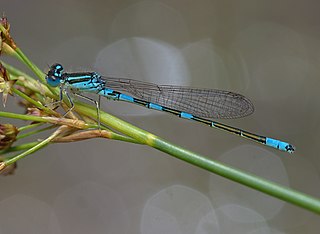 W
WThe dainty damselfly, also known as the dainty bluet, is a blue damselfly of the family Coenagrionidae. This is a scarce species found mainly in southern Europe, northern Africa, southwest Asia, and Central America. C. scitulum are Odonata predators that can reach a length of 30–33 mm at maturity and have hind-wing lengths of 15–20 mm. The males and females do exhibit differing features through their colouration making them easily distinguishable. As shown in the photo to the left, segment eight is blue in colour followed by black markings on segment nine, whereas the females are mostly black near the rear with smaller blue markings. Although they are relatively simple to sex, they are easily confused with the common blue damselfly.
 W
WEnallagma cyathigerum is a species found mainly between latitudes 40°N and 72°N; It is widely distributed in the Palearctic, and the Nearctic species Enallagma annexum was at one time considered to be synonymous with it. The species can reach a length of 32 to 35 mm. It is common in many different countries including Russia, Europe and South Korea. Damselflies are an important link between the health of the aquatic ecosystem and its response to climate change.
 W
WEpallage fatime, the Oriental damselfly, is a damselfly (Zygoptera) from the family of the Euphaeidae.
 W
WErythromma najas, the red-eyed damselfly, is a member of the Coenagrionidae family of damselflies.
 W
WThe Irish damselfly or crescent bluet is a damselfly found in northern Europe and Asia to north-eastern China;. It is common and widespread in northern Finland, scarce and local in the Netherlands and Ireland and rare elsewhere. One of its English name comes from the fact that it is found in Ireland but not in Britain. The alternative name, crescent bluet, refers to the shape of the markings on segment two of the male and its scientific name.
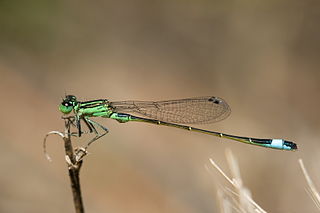 W
WIschnura genei, the island bluetail damselfly, is a species of damselfly that replaces the blue-tailed damselfly on some Mediterranean islands. It is a small and slender damselfly that tends to be smaller and daintier than the common bluetail. Its main distinguishing features include a black abdomen, which in males carries a striking blue tail-light on S8. Some female colour forms, too, have a blue tail-light on S8, but it tends to be interrupted by a black mark on either end. In some other female colour forms S8 is rusty brown. The male's pterostigma is bi-coloured. In Malta, this species is still frequent and breeds, but it is endangered by habitat loss.
 W
WThe Persian damselfly or Dumont’s bluetail is a damselfly, belonging to the family Coenagrionidae.
 W
WThe Large red damselfly, Pyrrhosoma nymphula, is a species of damselflies belonging to the family Coenagrionidae.
 W
WLestes barbarus is a species of damselfly of the family Lestidae, the spreadwings. Its common names in English include southern emerald damselfly, shy emerald damselfly, and migrant spreadwing.
 W
WLestes dryas is a species of damselfly in the family Lestidae, the spreadwings. Its common names include emerald spreadwing, scarce emerald damselfly and robust spreadwing. An alternate name in Ireland is the turlough spreadwing.
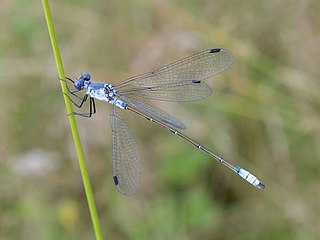 W
WLestes macrostigma is a species of damselfly of the family Lestidae, the spreadwings. It is known by the common name dark spreadwing. It is native to much of southern Europe, its distribution extending into western Asia.
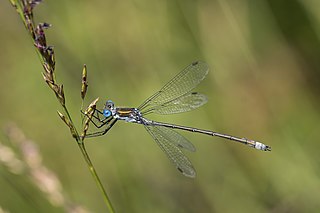 W
WLestes sponsa, is a damselfly, with a wide Palaearctic distribution. It is known commonly as the emerald damselfly or common spreadwing. Both males and females have a metallic green colour and when resting its wings are usually half opened.
 W
WLestes virens is a species of damselfly in the family Lestidae, the spreadwings. It is known commonly as the small spreadwing or small emerald spreadwing. It is native to much of Europe and western and central Asia.
 W
WNehalennia speciosa is a species of damselfly in the family Coenagrionidae. It is found in Austria, Belarus, Belgium, the Czech Republic, Denmark, Estonia, Finland, Germany, Italy, Japan, North Korea, Latvia, Lithuania, Luxembourg, the Netherlands, Poland, Romania, Russia, Slovakia, Sweden, Switzerland, Ukraine, possibly France, and possibly Kazakhstan. Its natural habitats are swamps, freshwater marshes, and open excavations. It is threatened by habitat loss.
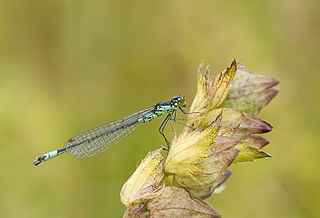 W
WNorfolk damselfly or dark bluet is a species of blue damselfly of the family Coenagrionidae. This species acquired its common name from its discovery in 1903 and presence in a very restricted area of the Norfolk Broads. Records came from Sutton, Stalham, and Hickling Broads.
 W
WPlatycnemis acutipennis, known as the Orange Featherleg or the Orange White-legged Damselfly, is a species of damselfly in the family Platycnemididae.
 W
WThe scarce blue-tailed damselfly or small bluetail is a member of the damselfly family Coenagrionidae.
 W
WThe small red damselfly is a small damselfly flying in heathland bogs and streams. It is in the family Coenagrionidae.
 W
WThe small red-eyed damselfly is a member of the damselfly family Coenagrionidae. It is very similar to the red-eyed damselfly.
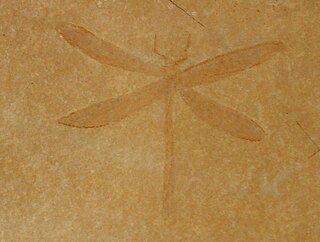 W
WSteleopteon is a genus of extinct winged damselflies whose fossils have been found in modern Germany, and Great Britain, and which lived at the end of the Jurassic and the beginning of the Cretaceous.
 W
WSteleopteron deichmuelleri is a species of extinct winged damselfly in the family Steleopteridae, which lived in modern Germany during the Upper Jurassic era.
 W
WThe variable damselfly or variable bluet is a European damselfly. Despite its name, it is not the only blue damselfly prone to variable patterning.
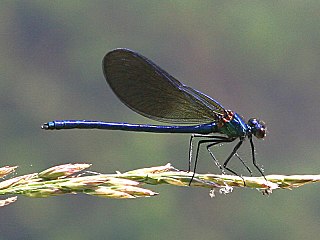 W
WThe western demoiselle or yellow-tailed demoiselle is a species of damselfly belonging to the family Calopterygidae. It replaces the banded demoiselle in southern France and the Iberian Peninsula, and is sometimes considered a subspecies of that species.
 W
WThe white-legged damselfly or blue featherleg is a damselfly of slow-flowing, muddy waters. It occurs from the Atlantic to Siberia and is often abundant throughout its range.